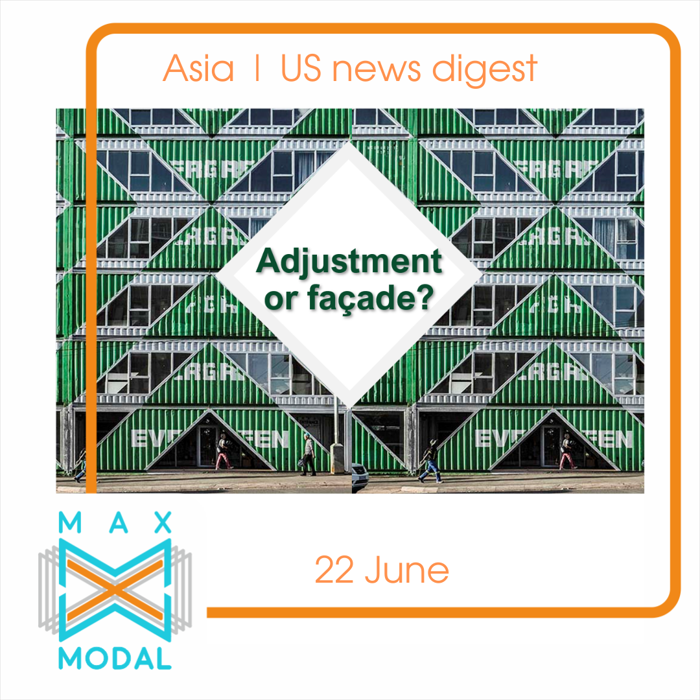Asia | US news digest. 22 June
Shrinking ocean capacity is forcing companies to switch their attention to different sectors for development. It is the matter of time before we see who is adjusting or who is only focused on keeping face.
With the epicenter in Yantian, the ship congesting keeps shaking up the ports around the world bringing a 300% increase in blank sailings just in one month. The numbers spill trouble across the maritime shipping world, and particularly for companies that rely on Asian routes, although even shipments not directly impacted by the Yantian situation could feel the disruption, as carriers adjust their networks to avoid congestion at YICT. As the result, the increased demand and worsening conditions are making the east-west alliance carriers to temporarily adjust their liner service networks. 2M Alliance has decided to change the sailing programs of its network to manage severe port congestions globally. In addition, Hapag-Lloyd has announced a new peak season surcharge from East Asia ports to North American destinations. The new splurge will amount to $1,000 per all 20' container types and 2,000 per all 40'.
Consequently, the perplexed context of the current reality is attracting new players – previously not even associated with trade – as opportunities for development and launches of new serviced emerge. BAL Container Line is set to launch a regular service between China and Los Angeles. Matson has announced the launch of a new seasonal China-US west coast "China-California Express" service for the peak season. The transpacific box shipping market is destined to become more crowded. Overall, the global containership orderbook continues to expand. Recently, Ever Given and SITC ordered more newbuildings. A similar type to the one of Ever Given is now valued at $180m. The global containership orderbook is now over 18% of the active fleet.
Meanwhile, there is hope that the Ever Given deal might move from the deadlock in the near future. UK P&I Club has delivered what it believes will be a satisfactory settlement to its dispute with the Suez Canal Authority – it has offered $150m deal, but experts expect that the level of compensation will likely be higher than that and lower than the $600m demanded by the SCA. The decision is yet to be announced, and again it is going to take a while since the court proceedings have been put on hold.
As ocean capacity keeps shrinking and the ongoing disputes are moving with the speed of a snail, Maersk implements its expansion strategy by launching its first block train intermodal service between Europe and China, using Malaszewicze, Poland, as an EU exit point. Transporting chemical cargo needs extra dedication, as it requires high levels of complexity. In turn, modal shift covers New Zealand’s exporters too, but in a different direction. Since the bottleneck in South China is causing further headaches more of the country’s exporters switch to airfreight to reach crucial overseas markets. Rail Cargo Group in Austria has welcomed its first train from China in the city of Graz.
At the same time, supply chain constraints are pushing up trucking rates. The current picture is worrying – according to recent data, the load-to-truck ratio elevated, increasing almost 220% YoY for vans, 674% YoY for flatbeds, and 324% YoY for reefers. Strong demand resulted in rates continuing to rise MoM and YoY across van, flatbed, and reefer.
Northwest Grains International has opened a new transload operation at Inland Port Dillion to improve the supply chain of containerized agricultural goods through the Port of Charleston.
Despite the splurge in demand, the e-commerce giant, Amazon, is going to launch its megasale, meaning that another mini-peak in sales is inevitable. However, experts argue that most sellers do not have the cash to bring in the inventory the storage of which they have to pay besides working with slim margins.
The green locomotive is rushing forward with the International Maritime Organisation that has adopted a new series of key mandatory measures to cut carbon emissions in container shipping, including a ship rating system to measure carbon intensity. Ships will get a rating of their energy efficiency (A, B, C, D, E – where A is the best). Administrations, port authorities, and other stakeholders are encouraged to provide incentives to ships rated as A or B also sending out a strong signal to the market. The Busan Port Authority has begun a joint study with the Korea Institute of Ocean Science and Technology on the impact of pollutants generated from vessels on air quality. Based on the study, BPA and KOST will be able to identify the impact of operating vessel emissions on the port area.

